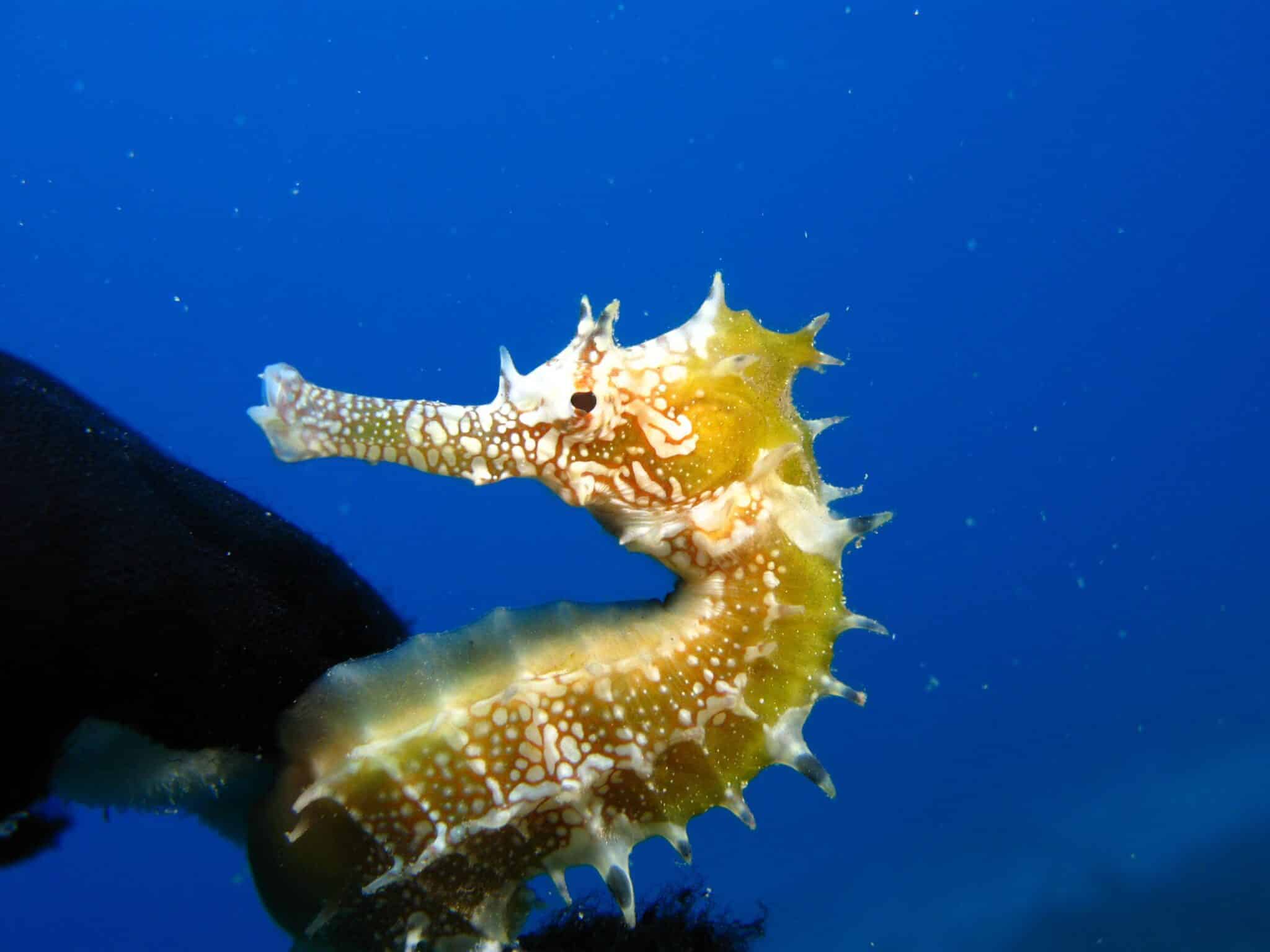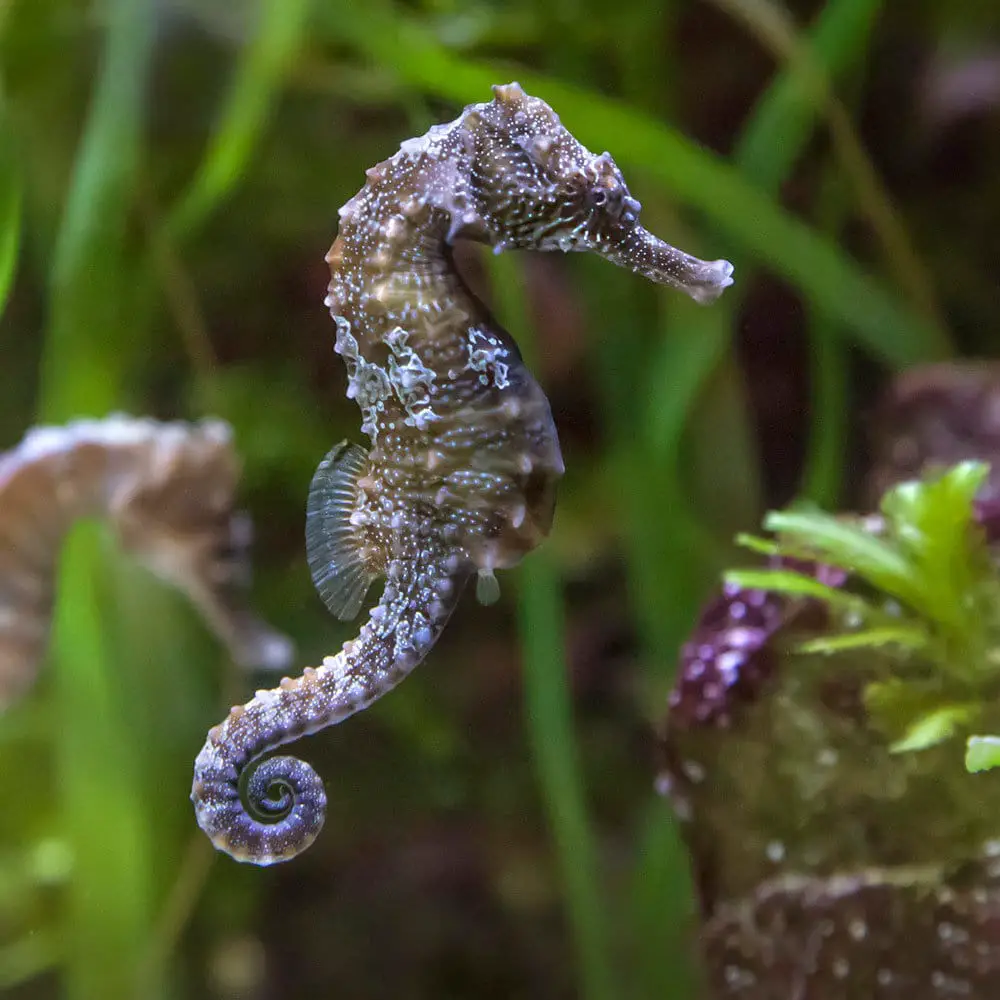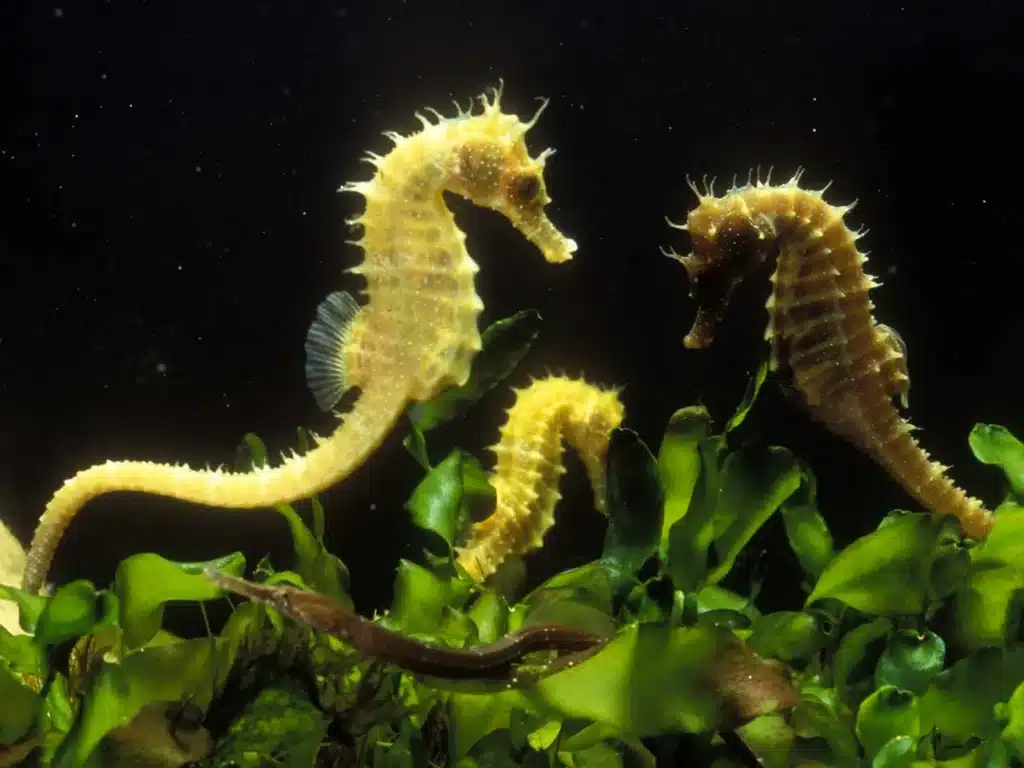Are Seahorses Reef Safe

Introduction
Are Seahorses Reef Safe: Seahorses are captivating and enchanting creatures found in marine environments around the world. Their unique appearance, upright posture, and delicate movements make them a favorite among marine enthusiasts and aquarists. However, when it comes to their compatibility with reef ecosystems and the term “reef-safe,” there are important considerations to keep in mind.
Seahorses are intriguing marine creatures known for their intricate behaviors and captivating appearance. While they are beloved by many, the question of whether they are considered “reef-safe” in the context of coral reef ecosystems is a subject of debate and concern among marine enthusiasts and conservationists. In this discussion, we will delve deeper into the complexities of seahorses’ interaction with coral reefs and the concept of reef-safe marine life.
Seahorses, with their graceful appearance and captivating behaviors, have always been a subject of fascination for marine enthusiasts and divers. Yet, when it comes to their compatibility with coral reef ecosystems and the term “reef-safe,” there are multifaceted aspects to consider. The interaction between seahorses and coral reefs, as well as their impact on other reef-dwelling organisms, raises important questions regarding their status as reef-safe marine creatures. In this exploration, we will delve into the complexities of this topic to understand the nuances of eat seahorses‘ presence in coral reef environments.

Are seahorses coral safe?
Seahorses are compatible with most soft corals like Zoanthus, Xenia, Cabbage leathers, Tree corals, Spaghetti Finger Leathers, Gorgonians, and small mushrooms. Compatible LPS are not able to consume a seahorse and do not sting. These include Tubastrea, Scolymia, Acanthastrea, Lobophyllia, Turbinaria, etc.
Feeding Behavior: One aspect that makes seahorses desirable for reef tanks is their diet. Seahorses primarily feed on small crustaceans and zooplankton, and they are not herbivorous like some other reef fish that may nip at or consume coral polyps. This reduces the risk of them damaging or disturbing coral colonies.
Habitat Requirements: Seahorses have specific habitat requirements, such as the need for perching sites like seagrass or artificial structures within the tank. While they may not directly interact with coral, providing appropriate perching and hiding spots is essential for their well-being.
Compatibility with Coral: In general, seahorses are not known to harm live corals. However, the reverse can sometimes be a concern. Some corals, particularly large stinging corals like anemones, may pose a risk to seahorses if placed too close, as they could inadvertently touch the seahorse with their stinging tentacles.
Tank Mates: The choice of tank mates is crucial. Seahorses are relatively slow swimmers and can be outcompeted for food by faster-moving fish. It’s important to select compatible tank mates that won’t harass or outcompete the seahorses.
Water Quality: Seahorses are sensitive to changes in water quality. Maintaining stable water parameters, such as temperature, salinity, and pH, is essential for their health.
Can seahorses be kept with clownfish?
Clownfish (Amphiprion ocellaris and Amphiprion percula)
These two species of clownfish are among the more peaceful species and what we recommend if you are going to try keeping them with your seahorses. Clownfish are an iconic marine aquarium fish species and very popular.
Dietary Differences: One key consideration is the dietary difference between seahorses and clownfish. Seahorses are primarily carnivorous and feed on small crustaceans and zooplankton. In contrast, clownfish are omnivores and often consume a mix of algae, small invertebrates, and fish flakes. To meet the dietary needs of both species, it’s important to provide a diverse and suitable diet for all inhabitants of the tank.
Tank Size and Layout: Seahorses are generally slow-moving creatures, while clownfish can be more active swimmers. Providing adequate space and a well-planned tank layout with hiding places for seahorses and suitable open swimming areas for clownfish is essential. Seahorses may benefit from vertical structures to grasp with their tails, as they are adapted to cling onto objects.
Water Parameters: Seahorses are sensitive to changes in water quality, so maintaining stable water parameters is crucial. Both species require proper filtration and regular water changes to ensure a healthy environment. Water temperature, salinity, and pH should be within the optimal ranges for both seahorses and clownfish.
Tank Mates: Careful selection of tank mates is important. Clownfish are generally less likely to harass seahorses compared to some other fish species. However, some clownfish can be territorial and may exhibit aggression toward other tank inhabitants. Choosing clownfish with a more peaceful temperament is advisable.
Compatibility and Observation: It’s important to closely monitor the behavior and interactions between seahorses and clownfish. Seahorses can be more vulnerable to aggressive tank mates, so any signs of stress or aggression should be addressed promptly. Separation or rehoming of incompatible tank mates may be necessary.
Do seahorses like coral reefs?
Habitat: All seahorses are marine species. They are typically found in seagrass beds, mangrove roots, and coral reefs, in shallow temperate and tropical waters. Some species can also be found in estuaries, as they are able to tolerate wide ranges in salinity.
Habitat Choice: Seahorses are known to inhabit a variety of marine environments, including seagrass beds, mangrove areas, and coral reefs. They are often found near the shelter of coral structures or other objects that offer perching and hiding spots. While they may not directly interact with coral polyps or consume coral, they rely on the presence of suitable structures for attachment and camouflage.
Protection and Camouflage: Seahorses have a unique appearance with their upright posture and intricate body patterns. They use their prehensile tails to anchor themselves to objects, such as coral branches or seagrass blades, to stay in place and avoid drifting with water currents. This allows them to blend into their surroundings and evade potential predators.
Biodiversity: Seahorses contribute to the biodiversity of coral reef ecosystems. Their presence adds to the overall richness and uniqueness of these underwater environments. Their behavior, including courtship rituals and parental care, also makes them a fascinating and important part of the reef ecosystem.
Conservation Concerns: While seahorses are associated with coral reefs, it’s important to note that coral reefs worldwide are facing threats, including habitat degradation, pollution, and climate change. These threats can impact seahorse populations indirectly by reducing the availability of suitable habitats and affecting the overall health of reef ecosystems.
Is it OK to touch seahorses?
Do not chase, disturb or touch seahorses. Seahorses are a protected species and it is an offence to disturb them. It is an exciting experience to see one but it is best for you and the seahorse to keep your distance and calmly observe. If the seahorse swims away, do not pursue it.
Stress: Seahorses are delicate and sensitive creatures. Handling them can cause significant stress, which may lead to health issues or even death. In the wild, seahorses rely on their ability to blend into their surroundings and avoid predators. Being touched disrupts this natural defense mechanism.
Injury Risk: Seahorses have fragile bodies and skin that can be easily damaged. Handling them can result in injuries, such as cuts or abrasions, which can become infected or lead to secondary health problems.
Transfer of Substances: Human hands can carry oils, chemicals, and contaminants that may be harmful to seahorses. Touching seahorses with sunscreen or other substances on your skin can potentially harm them.
Conservation Concerns: Many seahorse species are threatened due to habitat destruction and overexploitation for the aquarium trade and traditional medicine. Interacting with seahorses in the wild can disturb their natural behaviors and habitats, further contributing to their decline.
Legal Protection: In some regions and countries, it is illegal to handle or collect seahorses without proper permits or licenses due to their vulnerable status. Engaging in unauthorized activities can have legal consequences.
Can seahorses be aggressive?
Seahorses move slowly, they’re not aggressive — unless you happen to be a tasty shrimp — and they’re small — the largest are only about a foot long, while the smallest are no bigger than the tip of your little finger.
Territorial Behavior: While seahorses are not typically aggressive toward other seahorses or tank mates, they can exhibit territorial behavior, especially in confined spaces. In a home aquarium, seahorses may establish territories within the tank, particularly if there is competition for perching or hiding spots. This territorial behavior can manifest as seahorses defending their chosen location from other tank mates.
Feeding Interactions: Seahorses are slow-moving creatures and may not compete well with faster, more aggressive fish during feeding. In a community tank, it’s important to ensure that seahorses have access to their food without being outcompeted by faster swimmers.
Compatibility: Choosing appropriate tank mates for seahorses is crucial. Peaceful, slow-moving species are typically the best companions for seahorses. Avoid aggressive or territorial fish that might harass or stress the seahorses.
Pair Bonding: Seahorses are monogamous and form pair bonds, often staying close to their mate. They are not typically aggressive toward their own mate, and pair bonding is an essential part of their social behavior.
Stress and Handling: Handling or disturbances in the tank can cause stress in seahorses, which can, in rare cases, lead to aggressive behavior or erratic swimming. Minimizing disturbances and providing them with a calm and stable environment is essential.
Can seahorses and jellyfish live together?
Stinging animals like anemones and jellyfish are unsuitable, as are other predatory invertebrates such as lobsters, mantis shrimp, certain starfish and most crabs.
Feeding Differences: Seahorses are carnivorous and primarily feed on small crustaceans and zooplankton. They have specialized mouths and feeding behaviors suited to capturing and consuming these types of prey. In contrast, jellyfish are gelatinous and primarily feed on plankton, including small fish and other tiny organisms. Their feeding mechanisms involve capturing prey using specialized tentacles armed with stinging cells. The dietary needs and feeding methods of seahorses and jellyfish are quite different, making it challenging to provide suitable food for both in the same tank.
Compatibility: Seahorses are slow-moving, delicate creatures that can be easily stressed or injured by other tank inhabitants, especially those with stinging tentacles like jellyfish. Seahorses may not be equipped to avoid or defend against jellyfish stings, which could lead to harm or even death.
Tank Size and Conditions: Both seahorses and jellyfish have specific requirements for tank size, water quality, and temperature. Seahorses require stable and well-filtered aquariums with ample perching spots. Jellyfish require specialized tanks with controlled water flow and appropriate lighting conditions. Combining these two species in the same tank would likely result in suboptimal conditions for one or both.
Are seahorses hard to keep alive?
Though unique in their care needs, seahorses are surprisingly easy to keep (and even breed) if they are maintained in the proper type of fish aquarium system, kept with appropriate tankmates, and offered the right kinds of fish food. Most of all, they can be extremely rewarding to observe and care for.
Feeding: Seahorses require a constant supply of live food, typically small crustaceans and zooplankton. Feeding them can be time-consuming and may involve cultivating live food sources or obtaining them from specialized suppliers.
Water Quality: Seahorses are sensitive to changes in water quality, particularly ammonia and nitrite levels. Maintaining stable water parameters is crucial, and regular water testing and adjustments are necessary.
Tank Setup: Seahorses need a specific tank setup with low water flow, suitable perching spots (such as live or artificial plants), and gentle filtration systems. The tank should also be free of sharp or abrasive decorations that can injure their delicate skin.
Compatibility: Seahorses are peaceful animals and should not be kept with aggressive tank mates. Choosing suitable tank mates is essential to prevent stress or harm to the seahorses.
Temperature and Salinity: Seahorses require stable water temperature and salinity levels within a narrow range. Fluctuations can stress and harm them.
Can seahorses live with tangs?
Bear in mind that tangs are known as surgeonfish for a reason — they can do a lot of damage with their tail “scalpels” if they are so inclined — so you don’t want to crowd them together with seahorses in a small tank (remember how your schizoid yellow tang can go off on his tankmates unpredictably).
Dietary Differences: Seahorses are carnivorous and primarily feed on small crustaceans and zooplankton. Tangs, on the other hand, are herbivores and feed on algae and other plant matter. Their dietary requirements are fundamentally different, which can make it challenging to provide suitable food for both.
Tank Size: Both seahorses and tangs have specific requirements for tank size and water quality. Tangs are active swimmers and may require more space than a typical seahorse tank provides. Keeping both species in the same tank could lead to overcrowding and stress.
Compatibility: Seahorses are generally peaceful and slow-moving, while tangs can be more active and territorial. Tangs might compete with seahorses for space or even harass them, potentially causing stress or injury to the seahorses.
Water Flow: Seahorses prefer low water flow in their tanks, which is not typically suitable for the needs of tangs, as they may require stronger water movement to mimic their natural habitat.
Tankmates: When selecting tankmates for seahorses, it’s crucial to choose peaceful species that are compatible with their specific requirements and temperament. Tangs may not be the best choice due to their activity level and potential territorial behavior.

Conclusion
On the positive side, seahorses are generally not herbivores and do not consume coral polyps, which distinguishes them from some other reef inhabitants that can damage coral structures. Additionally, their presence may contribute to the overall biodiversity and uniqueness of a reef.
However, there are considerations to keep in mind. Seahorses are fragile and can be easily stressed by human activities, such as collecting for the aquarium trade or habitat destruction. Furthermore, their reliance on specific habitats, such as seagrass beds and coral reefs, means that any damage to these environments can impact seahorse populations.
Ultimately, responsible and sustainable practices are essential to ensure that seahorses can coexist with coral reefs in a manner that benefits both the seahorses and the delicate reef ecosystems. Conservation efforts, protection of their habitats, and responsible aquarium keeping can contribute to a more harmonious relationship between bred seahorses and coral reefs.



